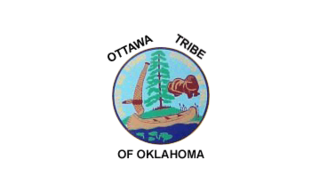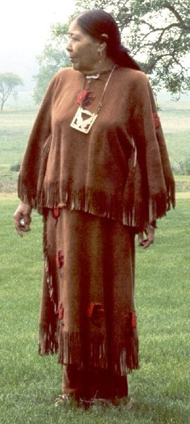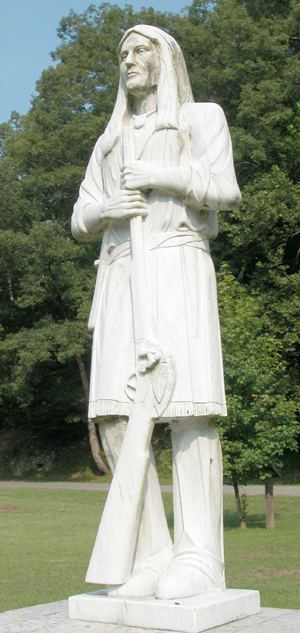Government
The headquarters of the Eastern Shawnee Tribe are Wyandotte, Oklahoma, and their tribal jurisdictional area is in Ottawa County, Oklahoma. There are 3,787 enrolled tribal members, and 904 of them living within the state of Oklahoma. Some live nearby in Missouri, where the tribe has a Cultural Preservation Center at Seneca, Missouri, and a community in western Missouri.
Glenna J. Wallace is the elected chief, since 2006, and is currently serving a four-year term. She is the tribe's first female chief. [1] The Eastern Shawnee Tribe issues its own tribal vehicle tags. [1]
Membership in tribe is based on documented lineal descent to persons listed on the Dawes Rolls. [1] The tribe has no minimum blood quantum requirements.
History
The Eastern Shawnee Tribe of Oklahoma are primarily descendants of Shawnees who lived in Ohio until the 1830s. The Shawnees, an Eastern Woodland tribe who were once nomadic, occupied territory throughout what became the eastern United States, living in present-day Ohio, Virginia, West Virginia, Western Maryland, Kentucky, and Pennsylvania. [3] In the late 18th century, European-American encroachment crowded Shawnee lands in the east, and one band migrated to Missouri, eventually becoming the Absentee Shawnee tribe. [3]
Three reservations were granted to the Shawnees in Ohio by the 1817 Treaty of Fort Meigs: Wapakoneta, Lewistown, and Hog Creek. [4] After the Indian Removal Act of 1830 passed, the Lewiston band, who lived with a group of Senecas, relocated to Indian Territory in July 1831, and were known as the "Mixed Band" of Senecas and Shawnees. Another band, who would become the federally recognized Shawnee Tribe, relocated to Kansas in August 1831. [3]
The US federal government carved out a 60,000-acre (240 km2) reservation for the "Mixed Band" or United Nation of Senecas and Shawnees from Cherokee lands in Indian Territory in 1832. A treaty was negotiated between the US and the Seneca and Shawnee in 1867, which made portions of their land available to other tribes, and restored the independence of the Seneca and Shawnee tribes. They were from different language families, Iroquoian and Algonquian, respectively. [2] The Shawnees of the "Mixed Band" became the Eastern Shawnee Tribe. [2] The Eastern Shawnee organized as a federally recognized tribe under the 1936 Oklahoma Indian Welfare Act. [2]
In May 2019, the Eastern Shawnee ceremonial grounds flooded with three feet of water. Thirty families were evacuated, and "local roads stayed impassable for weeks." Tribal leaders have joined the city of Miami in opposition to increased water levels at Pensacola Dam and Grand Lake. They argue that when the water backs up downstream on the Neosho River, it can increase problems with flooding in their communities. [5]
Flag
The tribe's flag displays our tribal seal on a white (sometimes red) field. The seal displays the Me-she-Pe-She, the panther, and the Wa-be-the, the swan. The story of the beginning of our tribe was recorded by George Blue Jacket in 1829 as a record of the tale passed down through generations of Shawnee people.
The story goes that the Grandmother of Shawnee people came across the great salt water (Atlantic Ocean, presumably) holding the tail of a panther and our Grandfather was carried on the back of a swan, thus beginning the Shawnee People. The Panther also represents courage, strength, and prowess in battle. The Swan symbolizes tranquility, peace and beauty. The symbolism of these two animals contrasts just as distinctly as the black and white colors contrast. The two feathers on the spear symbolize our dual citizenship in the United States and Eastern Shawnee Tribe of Oklahoma. The spear itself represents that we will fight to our death to defend this universe that we hold as sacred.
All of this sits inside of a circle, representing the univers; continuous, never-ending, with no beginning nor no ending, only one world, one universe, one tribe united. The round shape encircles and holds all of the other objects, just as the tribe holds all of its members as one. The shape with four eagle feathers at the bottom. The four feathers hold significance to our tribe and many others as a symbol of the four elements, four winds and four directions. Eagle feathers were used for our flag due to the fact that the Eagle is the most revered of all species and symbolizes courage, strength and spirit. The Eagle is said to be the closest to the Creator and rumored to have even seen the Creator's face. [6]

The Shawnee are an Indigenous people of the Northeastern Woodlands. Their language, Shawnee, is an Algonquian language.

The Peoria are a Native American people. They are enrolled in the federally recognized Peoria Tribe of Indians of Oklahoma headquartered in Miami, Oklahoma.

The Wyandotte Nation is a federally recognized Native American tribe headquartered in northeastern Oklahoma. They are descendants of the Wendat Confederacy and Native Americans with territory near Georgian Bay and Lake Huron. Under pressure from Haudenosaunee and other tribes, then from European settlers and the United States government, the tribe gradually moved south and west to Michigan, Ohio, Kansas, and finally Oklahoma in the United States.

The Quapaw or Arkansas, officially the Quapaw Nation, is a U.S. federally recognized tribe comprising about 5,600 citizens. Also known as the Ogáxpa or “Downstream” people, their ancestral homelands are traced from what is now the Ohio River, west to the Mississippi River to present-day St. Louis, south across present-day Arkansas and eastern and southern Oklahoma. The government forcibly removed them from Arkansas Territory in 1834. The tribal capital is Quapaw, Oklahoma.

The Iowa Tribe of Oklahoma is one of two federally recognized tribes for the Iowa people. The other is the Iowa Tribe of Kansas and Nebraska. Traditionally Iowas spoke the Chiwere language, part of the Siouan language family. Their own name for their tribe is Bahkhoje, meaning, "grey snow," a term inspired by the tribe's traditional winter lodges covered with snow, stained grey from hearth fires.

Citizen Potawatomi Nation is a federally recognized tribe of Potawatomi people located in Oklahoma. The Potawatomi are traditionally an Algonquian-speaking Eastern Woodlands tribe. They have 29,155 enrolled tribal members, of whom 10,312 live in the state of Oklahoma.

The Shawnee Tribe is a federally recognized Native American tribe in Oklahoma. Formerly known as the Loyal Shawnee, they are one of three federally recognized Shawnee tribes. The others are the Absentee-Shawnee Tribe of Indians of Oklahoma and the Eastern Shawnee Tribe of Oklahoma.
The United Remnant Band of the Shawnee Nation, also called the Shawnee Nation, United Remnant Band (URB), is an organization that self-identifies as a Native American tribe in Ohio. Its members identify as descendants of Shawnee people. In 2016, the organization incorporated as a church.

The Ottawa Tribe of Oklahoma is one of four federally recognized Native American tribes of Odawa people in the United States. Its Algonquian-speaking ancestors had migrated gradually from the Atlantic coast and Great Lakes areas, reaching what are now the states of Michigan and Ohio in the 18th century. In the late 1830s the United States removed the Ottawa to west of the Mississippi River, first to Iowa, then to Kansas in what was Indian Territory.

The Absentee Shawnee Tribe of Indians of Oklahoma is one of three federally recognized tribes of Shawnee people. Historically residing in what became organized as the upper part of the Eastern United States, the original Shawnee lived in the large territory now made up of Pennsylvania, Kentucky, Tennessee, Ohio, Indiana, Illinois, and neighboring states. In total, they occupied and traveled through lands ranging from Canada to Florida, and from the Mississippi River to the eastern continental coast.

The Seneca–Cayuga Nation is one of three federally recognized tribes of Seneca people in the United States. It includes the Cayuga people and is based in Oklahoma, United States. The tribe had more than 5,000 people in 2011. They have a tribal jurisdictional area in the northeast corner of Oklahoma and are headquartered in Grove. They are descended from Iroquoian peoples who had relocated to Ohio from New York state in the mid-18th century.

The Modoc Nation is a federally recognized tribe of Modoc people, located in Ottawa County in the northeast corner of Oklahoma and Modoc and Siskiyou counties in northeast California. The smallest tribe in the state, they are descendants of Captain Jack's band of Modoc people, removed in 1873 after the Modoc Wars from their traditional territory in northern California and southern Oregon. They were exiled to the Quapaw Agency in Indian Territory, where they were colocated with the Shawnee people from east of the Mississippi River.
The Quapaw Indian Agency was a territory that included parts of the present-day Oklahoma counties of Ottawa and Delaware. Established in the late 1830s as part of lands allocated to the Cherokee Nation, this area was later leased by the federal government and known as the Leased District. The area that became known as the Quapaw Agency Lands contained 220,000 acres and was located in the northeastern corner of Oklahoma where that state adjoins Missouri and Kansas.

The Miami Tribe of Oklahoma is the only federally recognized Native American tribe of Miami Indians in the United States. The people are descended from Miami who were removed in the 19th century from their traditional territory in present-day Indiana, Michigan and Ohio.

The Delaware Tribe of Indians, formerly known as the Cherokee Delaware or the Eastern Delaware, based in Bartlesville, Oklahoma, is one of three federally recognized tribes of the Lenape people in the United States. The others are the Delaware Nation based in Anadarko, Oklahoma, and the Stockbridge-Munsee Community of Wisconsin. More Lenape or Delaware people live in Canada.

The Mingo people are an Iroquoian group of Native Americans, primarily Seneca and Cayuga, who migrated west from New York to the Ohio Country in the mid-18th century, and their descendants. Some Susquehannock survivors also joined them, and assimilated. Anglo-Americans called these migrants mingos, a corruption of mingwe, an Eastern Algonquian name for Iroquoian-language groups in general. The Mingo have also been called "Ohio Iroquois" and "Ohio Seneca".

The Cherokee Nation was a legal, autonomous, tribal government in North America recognized from 1794 to 1907. It was often referred to simply as "The Nation" by its inhabitants. The government was effectively disbanded in 1907, after its land rights had been extinguished, prior to the admission of Oklahoma as a state. During the late 20th century, the Cherokee people reorganized, instituting a government with sovereign jurisdiction known as the Cherokee Nation. On July 9, 2020, the United States Supreme Court ruled that the Muscogee (Creek) Nation had never been disestablished in the years before allotment and Oklahoma Statehood.
On the eve of the American Civil War in 1861, a significant number of Indigenous peoples of the Americas had been relocated from the Southeastern United States to Indian Territory, west of the Mississippi. The inhabitants of the eastern part of the Indian Territory, the Five Civilized Tribes, were suzerain nations with established tribal governments, well established cultures, and legal systems that allowed for slavery. Before European Contact these tribes were generally matriarchial societies, with agriculture being the primary economic pursuit. The bulk of the tribes lived in towns with planned streets, residential and public areas. The people were ruled by complex hereditary chiefdoms of varying size and complexity with high levels of military organization.

Quatawapea or John Lewis, also known as Captain Lewis and Colonel Lewis and ‘’’Captain Johnny’’’, was a Shawnee leader for whom Lewistown, Ohio, is named.
















